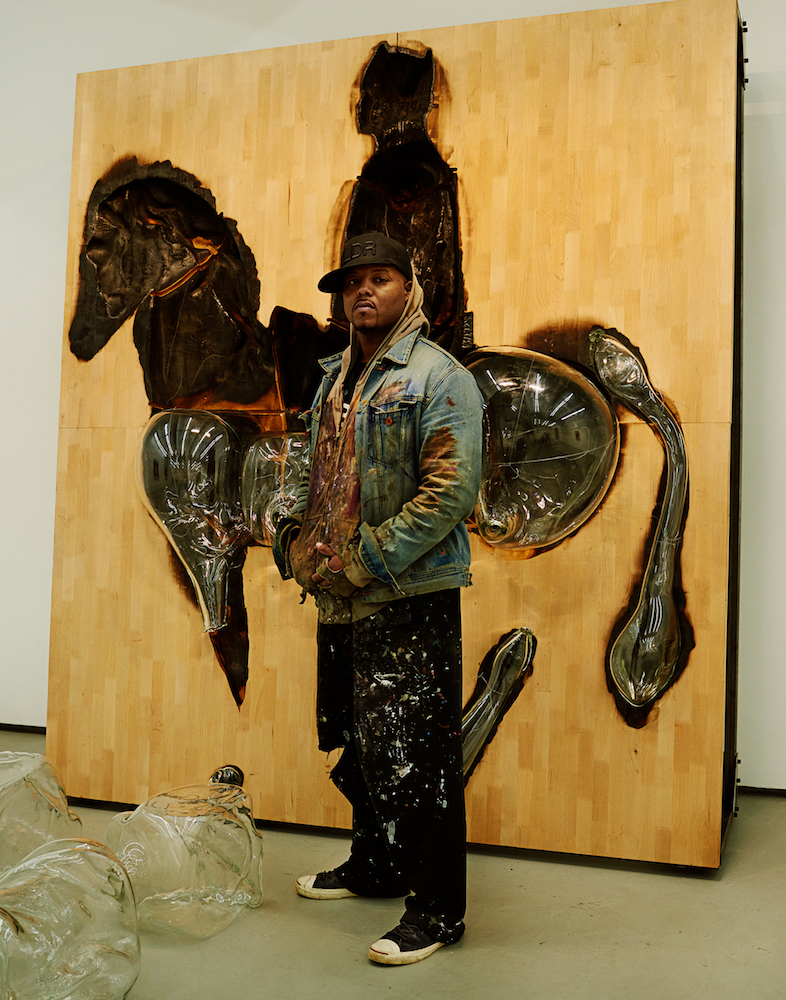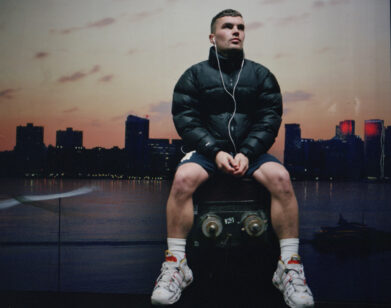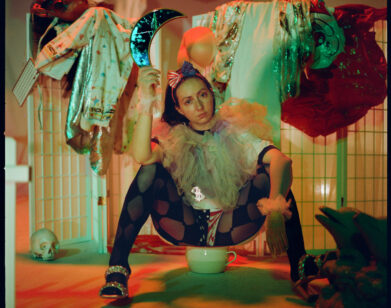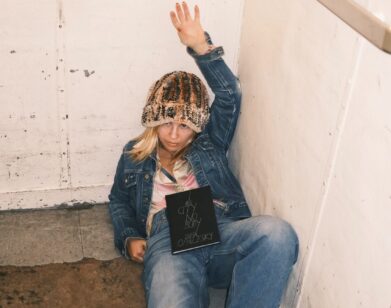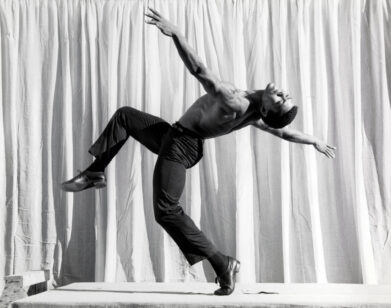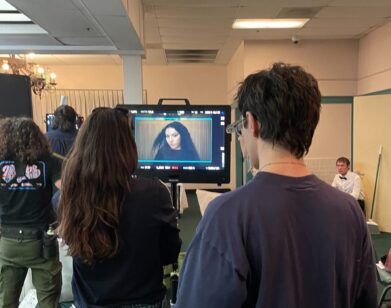Amending American History with Titus Kaphar
TITUS KAPHAR IN NEW YORK, DECEMBER 2016. PHOTOS: CHRISTIAN HÖGSTEDT.
By bringing both recent and distant histories to the fore of his art, Titus Kaphar provides a captivating and informed take on our present reality. He leaves it up to the viewer to do what they will with the revelations he offers, but the impetus is to respond to the injustice you have been shown with action.
Kaphar’s ability to draw attention to moral crises that are at once modern and age-old is a clear strength of his practice (his 2014 series The Jerome Project, for example, set a keen eye on injustices in America’s criminal justice system), and one that is particularly patent in his latest exhibition, “Shifting Skies,” currently on view at Jack Shainman Gallery in New York. His paintings and sculptures continually interrogate how narratives of American history either forget black people or malign them. While some works are direct responses to mass incarceration or police brutality, others plunge further into the past, focusing on the plight of the slaves owned by George Washington, a supposedly liberatory figure.
Ahead of the show’s opening, Interview met with Kaphar—who is based between New York and Connecticut—to discuss history’s blind spots and why “better” isn’t enough.
ELOISE BLONDIAU: I didn’t realize how specific the histories are that you’re dealing with in this exhibition.
TITUS KAPHAR: This is one of the first times it’s gotten this specific. I decided to focus on George Washington for the first time, and as we’re thinking about elections and presidents, it’s really interesting to think about the first time all of this happened. That’s where the specificity comes from. Also, my family has always—with no evidence—believed that our family was on Jefferson’s plantation, and it’s something that all of my family members talk about. I don’t know where that comes from, but it’s this lore. My wife’s family is directly related to George Washington and they have all the documentation; it’s something her family is very proud of.
[gestures to Ona Judge: Portrait in Tar, which depicts a woman in a pink dress whose face is covered by tar] This is my Ona Judge. Ona was a young black woman that George Washington enslaved. She came with Martha [Washington]’s dowry of sorts, and Ona kept running away. She had one major runaway, and she ran away because George Washington brought her to Philadelphia, and it was the first time she had seen all these free black people.
[Ona] sort of talked herself out of slavery. She convinced someone to take her on a boat, and she ended up in New Hampshire some place—started a whole new life for herself. So George Washington installed this advertisement looking for her—they called her “Oney,” and she hated that name. And in the advertisement they are just perplexed as to why she would ever run away. No idea why she might have run away! They think she might have been seduced by a Frenchman.
It’s so weird to have these things written at the same time as talking about liberty for everyone. Imperfect God, [a George Washington biography by Henry Wiencek,] is just an amazing book. It speaks to how [Washington] understood this problem, and he was in distress about it. [points to Absconded from the Household of the President of the United States, which depicts Washington’s face obscured by a shredded document] So this document is actually the entire written newspaper advertisement for her to come back. And that portrait [Ona Judge: Portrait in Tar] is my ode to her.
BLONDIAU: So the purpose of your pieces are to actually show Ona’s perspective in a way that those documents do not.
KAPHAR: Exactly. The other thing we know about her is that she was a seamstress, and she made all of Martha’s clothing. So that’s part of the reason she’s dressed up like this.
BLONDIAU: How do your sculptures interact with these portraits of Ona and George Washington?
KAPHAR: I took my two sons to the Natural History Museum, and we were outside, and there’s that equestrian sculpture of Teddy Roosevelt, then on the right-hand side of him is an African-American and on the left hand side of him is a Native American. And as we’re walking into the museum my 9-year-old son goes, “Daddy, how come he gets to ride on the horse and those two guys have to walk?”
And I said to myself, “Therein lies the complexity, all the complexity, of American history, spouted from the mouth of a 9-year-old.” What I realized in that moment is that we have all of this public sculpture, all of these national monuments that don’t actually reflect our contemporary values anymore. So I started thinking, “Is there a way to amend public sculpture?” And so that’s where this project came from.
Right now my project is to go around the country and scan these national monuments and try to make these “amendments”—not to remove those monuments, not to take them down, but in the same way as we do to the constitution, when we change the laws we add an amendment.
So the idea is that I’ve been travelling all around the country, doing all the research, placing all these pieces approximate to the actual monuments, and that those sites will become spaces of civic dialogue, where we can come and have conversations about politics and things like that, and compare and contrast.
BLONDIAU: It seems that this exhibition and your previous work, such as The Jerome Project, use history in a way that reveals something about now, and shape how stories are told right now.
KAPHAR: The way that I’ve tended to put it is: All of depiction is fiction, it’s only a question of degree. When we think of images, such as the signing of the declaration of independence, we think of that wonderful [John] Trumbull [painting Declaration of Independence] that is at the Yale Art Gallery and on the back of our money. When we think of that historical moment we think of that image. That image never happened like that. All of those people were never in that room together to sign that paper. It’s a beautiful fiction to help us have an understanding of what went on.
That’s the nature of representation; every time we represent something we alter it and slightly change it. And so with that as my foundation, understanding that it’s always fictional to some degree, I give myself a certain freedom to really explore and ask myself questions. What might not have been understood at that time? What might have been hidden at that time? What narrative in this particular image wasn’t the primary image, but is really important? That is really interesting to me, and then I try to tease that out as much as I can.
BLONDIAU: So, with regard to your body of work that deals with mass incarceration, it’s still representation, it’s still slicing up history, but it’s a different era. Why do people romanticize older histories?
KAPHAR: I’m not sure how to answer that question, but this is what it makes me think of; this is something that happens a lot: We look back at history, and there are certain people who say that we can’t judge them based on our contemporary morals. I think that’s a problematic argument, and the reason I think that’s problematic is that it presumes a kind of moral superiority that we have access to only in this contemporary time, which makes no sense to me. I mean, ask ourselves, what are the things that our children are going to be saying, “Oh my god, how did you let that happen?” about?
BLONDIAU: What led you to create The Destiny Project?
KAPHAR: I had started The Jerome Project, which as you know is about the relationship with my father [and his incarceration]. … I realized that I had been so focused on the impact of the criminal justice system on men that I really hadn’t thought about it broadly enough to consider the impact on women and women of color in particular. So I started doing more research and this is the project that came about: The Destiny Project. It’s a continuation of The Jerome Project series and this body of work is working with the same databases—mugshot.com, busted.com—finding these women who are all incarcerated, all of these photographs, and all these women have the same name.
And what’s happening here is that there are three different individuals—three sets of eyes—and all of them have the same name. All of them are incarcerated, and there’s this overlapping that happens, this blurring that happens, and it makes the image difficult to look at and focus on. It should be challenging, it should be uncomfortable, it shouldn’t be a pretty picture that you look at and you feel good about. It should be disturbing on some level.
BLONDIAU: It’s really emotional, actually, being in this room with these women looking out at you.
KAPHAR: Talk about emotional, I made this work and I found myself entering a depression that I was really troubled by, and I really had a hard time getting out of it.
When the Sandra Bland stuff happened, I was watching that footage over and over again. And I was saying, “Why are you doing this to yourself?” And I kept watching it, and I stopped it. And I thought, “What are you looking for?” And I realized that I was looking for the telltale moment to get some understanding of what was going on. And there was no moment. This whole tool of dashcam is rendered useless when people choose to do something as horrible yet simple as saying, “I’m just going to step out of this frame.”
BLONDIAU: And the reason the dashcam isn’t helpful is because of the person who has that camera, right? And so in a way the work that you’re doing is holding up your own lens, and not having to rely on someone else’s camera.
KAPHAR: Right. So I don’t see this body of work and that body of work [related to historical figures] as truly disconnected. History is a continuum, it’s not these separate moments. That’s how we look at it.
In the 1700s in Virginia before there were police officers—there were these groups of men who would wander the countryside—and if they saw a black man or a black woman they would presume that that black man or woman was a slave. If you didn’t have the kind of pass that you were supposed to have, then you could be whipped, you could be enslaved, you could be taken into custody—even if you were free. And as I’m reading this I find myself thinking, “How is this any different from stop-and-frisk?”
This is 10th Ave., one block from here, my brother—I was adopted when I was 15, this is my birth brother from Michigan—my brother says, “I want to see you.” My mom is concerned about him because he’s getting into trouble and she says, “Can you send him out to New York so he can talk to you and hang out with you and get himself back on track?” The first day was kind of boring; my brother didn’t really want to talk about much. The second day, I talked to him a little bit. The third day, we were making some headway, and then finally he says, “You know, I want to go see your art.” And I said “Really? You’ve got no interest in my art, but okay.” So we came here and walked down the street, in and out of galleries, up and down the street. I thought we were going to be here for 15 to 20 minutes, and we stayed walking around for two hours, and he was just enjoying it, and we were talking about it.
After two hours of walking, an undercover police car speeds up to us, puts their guns up on us, and forces our hands up against a wall. They said, “We’ve been getting complaints that there are black men walking in and out of the galleries stealing art work. We’ve been following you for the last two hours.” I have artwork in the gallery! Why would I be stealing it? That doesn’t even make any sense.
My point is that it’s not so different now. I’m not saying that things aren’t better. Thank God they’re definitely better, but some things are still the same. “Better” is not good enough—it’s not. Especially when “better” still means my life is at risk.
“SHIFTING SKIES” IS ON VIEW AT JACK SHAINMAN GALLERY IN NEW YORK THROUGH JANUARY 28, 2017.

